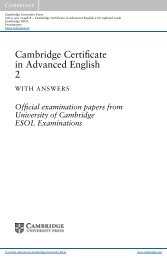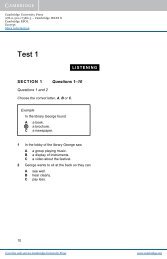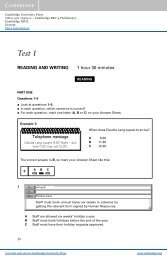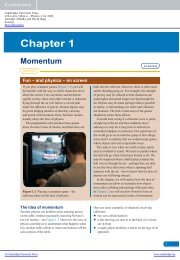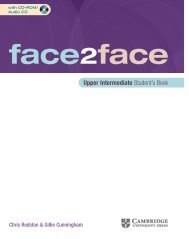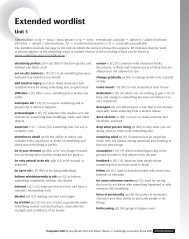Skills for Study Level 2 Teacher's Book - Cambridge University Press
Skills for Study Level 2 Teacher's Book - Cambridge University Press
Skills for Study Level 2 Teacher's Book - Cambridge University Press
You also want an ePaper? Increase the reach of your titles
YUMPU automatically turns print PDFs into web optimized ePapers that Google loves.
Assignment 1aAnswersArid: A very dry region of the world. The UN defines arid and semi-arid regionsby the amount of precipitation divided by the amount of water / moisture lostback to the atmosphere or into plants be<strong>for</strong>e it can be used by humans. Aridand semi-arid areas are estimated to cover about 30% of the world’s surface.Source: UNSO/UNDP. (1997). An Assessment of Population <strong>Level</strong>s in the World’sDrylands: Aridity Zones and Dryland Populations. New York: Office to CombatDesertification and Drought.Evaporation: Water / moisture lost back to the air.Precipitation: Water falling from the atmosphere (rainfall, dew, snow, etc.)Irrigation: Using artificial means to water crops. There are two types ofagriculture: rainfed (all water used is from natural rainfall) and irrigated.Salinity: The amount of salt in water.Scarcity: Lack / relative absence of something desirable.bcStudent discussionAnswers2.6How arid and semiarid regions are definedAreas of the world where a very dry climate means that there is constantscarcity of water. A ratio: average amount of yearly rain divided by the amountof that water which is lost back to the atmosphere be<strong>for</strong>e humans can use it.It’s lost back to the atmosphere when it evaporates off the land, or is breathedout by plants in a pair of processes known as ‘evapotranspiration’.Areas of the world classed as arid or semiaridUNEP (United Nations Environment Programme) classes about 30% of thetotal land surface in the world as arid or semi-arid, including North Africa andthe Middle East; the Sahel region of Africa south of the Sahara; large partsof central Asia; western areas of the USA; some parts of south America; andAustralia.The water problems that these regions of the world faceThree main issues:1 Very little water available in the first place. Typical rainfall in the arid regionscan be 100 mm or less per year, compared with averages of 750 mm in otherregions of the world.2 Arid / semi-arid regions are very vulnerable to drought, and the impacts ofdrought tend to be more serious <strong>for</strong> the environment and the communitieswhich rely on the land <strong>for</strong> food.3 Arid / semi-arid regions tend to have wide variations in the reliability of theirwater supplies – in some years there might be a relatively high amount of rain,while in others, none at all, so it is hard to get a reliable supply.Also, a lot of water is needed <strong>for</strong> agriculture, and industry / economic growthbut as there is little precipitation, it must be sourced from elsewhere.Unit 2 Part A ∙ Understanding spoken in<strong>for</strong>mation 42



